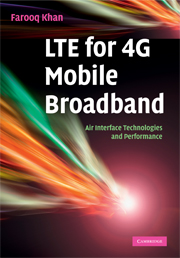Book contents
- Frontmatter
- Contents
- Preface
- 1 Introduction
- 2 Network architecture and protocols
- 3 Downlink access
- 4 Single-carrier FDMA
- 5 Reducing uplink signal peakiness
- 6 Transmit diversity
- 7 MIMO spatial multiplexing
- 8 Channel structure and bandwidths
- 9 Cell search and reference signals
- 10 Random access
- 11 Channel coding
- 12 Scheduling, link adaptation and hybrid ARQ
- 13 Power control
- 14 Uplink control signaling
- 15 Downlink control signaling
- 16 Inter-cell interference control
- 17 Single frequency network broadcast
- 18 Spatial channel model
- 19 LTE performance verification
- Index
17 - Single frequency network broadcast
Published online by Cambridge University Press: 28 February 2011
- Frontmatter
- Contents
- Preface
- 1 Introduction
- 2 Network architecture and protocols
- 3 Downlink access
- 4 Single-carrier FDMA
- 5 Reducing uplink signal peakiness
- 6 Transmit diversity
- 7 MIMO spatial multiplexing
- 8 Channel structure and bandwidths
- 9 Cell search and reference signals
- 10 Random access
- 11 Channel coding
- 12 Scheduling, link adaptation and hybrid ARQ
- 13 Power control
- 14 Uplink control signaling
- 15 Downlink control signaling
- 16 Inter-cell interference control
- 17 Single frequency network broadcast
- 18 Spatial channel model
- 19 LTE performance verification
- Index
Summary
Voice communication and download data services such as web browsing are based on point-to-point (PTP) communication. On the other hand, multicast and broadcast services are based on point-to-multipoint (PTM) communication, where data packets are simultaneously transmitted from a single source to multiple destinations. Examples of broadcast services are radio and television services that are broadcast over the air or over cable networks and the content is available to all the users. Multicast refers to services that are delivered to users who have joined a particular multicast group. The service delivery using point-to-multipoint (PTM) communication is generally more efficient when a large number of users is interested in receiving the same content such as a mobile TV channel. This results in efficient transmission not only over the wireless link but also in the core and access networks. This is because a single multicast broadcast packet travels in the core and access networks and is copied and forwarded to multiple Node-Bs in the multicast broadcast area.
The broadcast services can be delivered to mobile devices either via an independent broadcast network such as DVB-H (digital video broadcast-handheld), DMB (digital multimedia broadcast), MediaFLO or over a service provider's cellular network. The DMB is a South Korean standard derived from the digital audio broadcast (DAB) standard. In the case of an independent broadcast network, dual mode UEs capable of receiving service from both the broadcast network and the cellular network are required.
- Type
- Chapter
- Information
- LTE for 4G Mobile BroadbandAir Interface Technologies and Performance, pp. 426 - 447Publisher: Cambridge University PressPrint publication year: 2009

